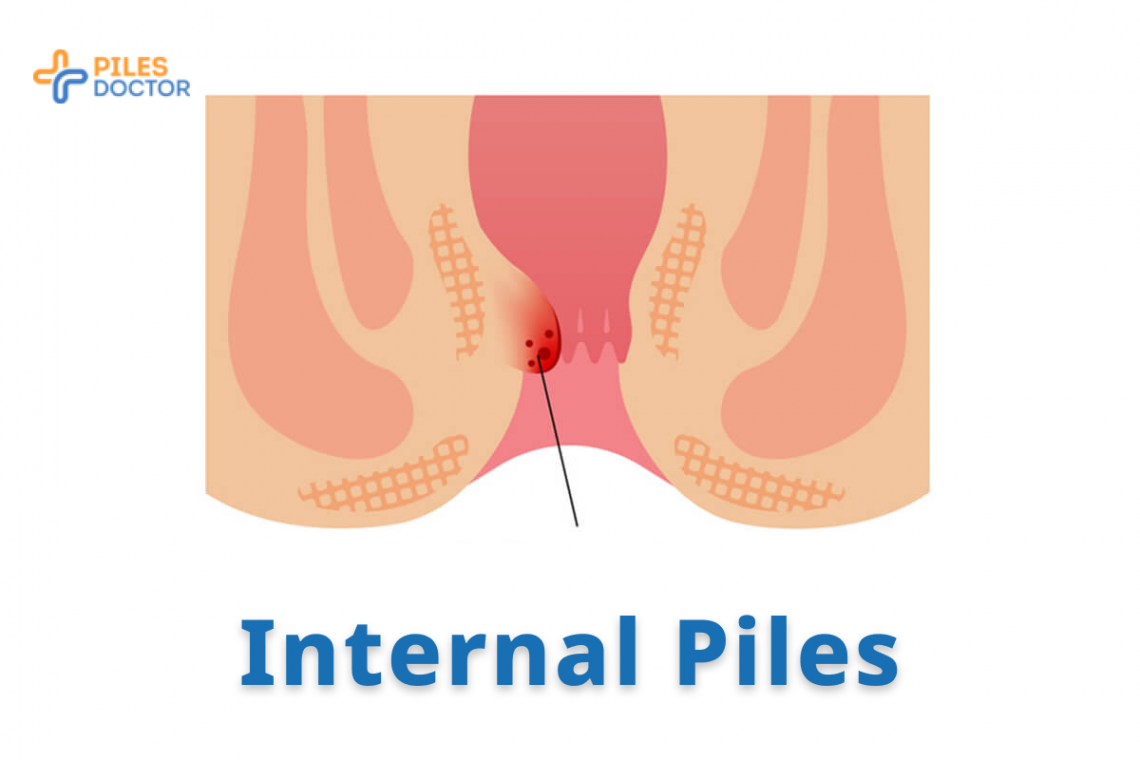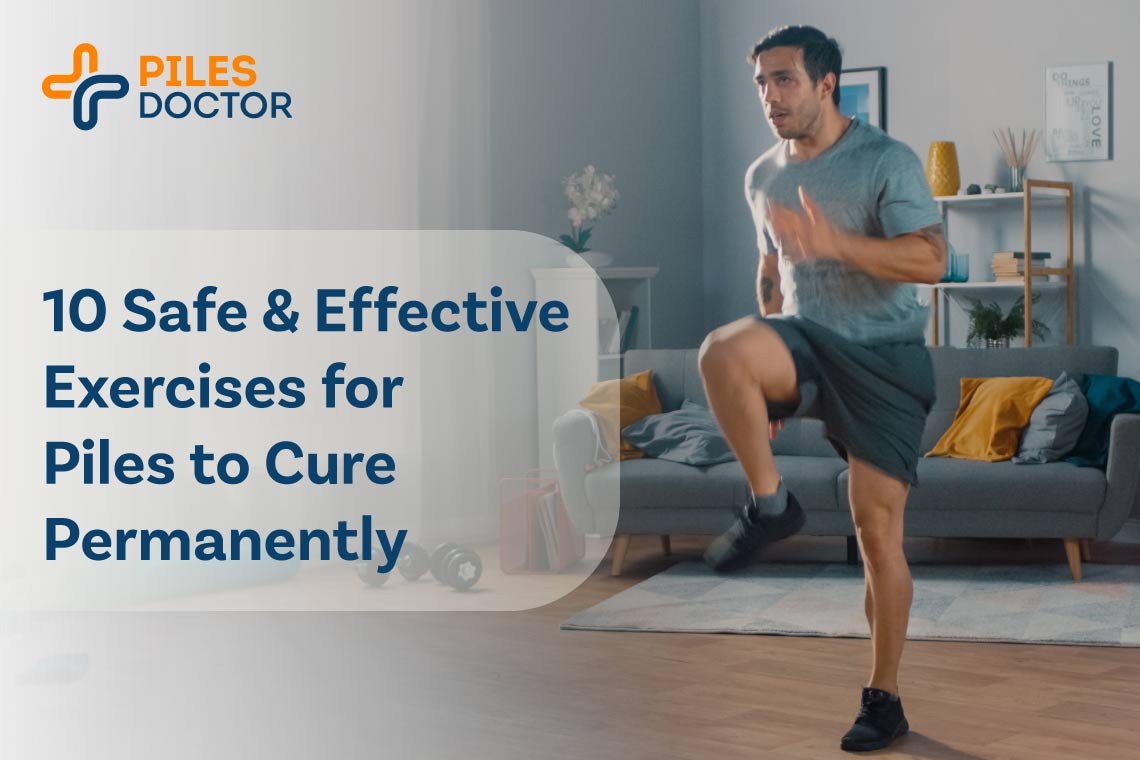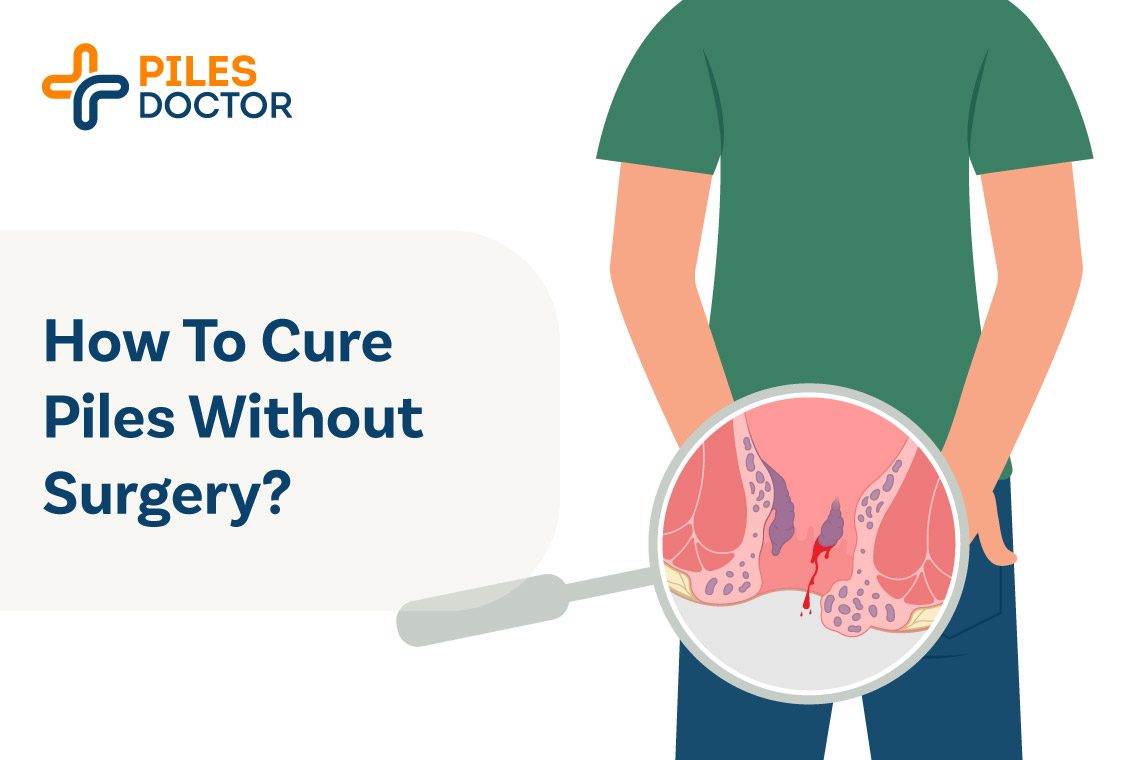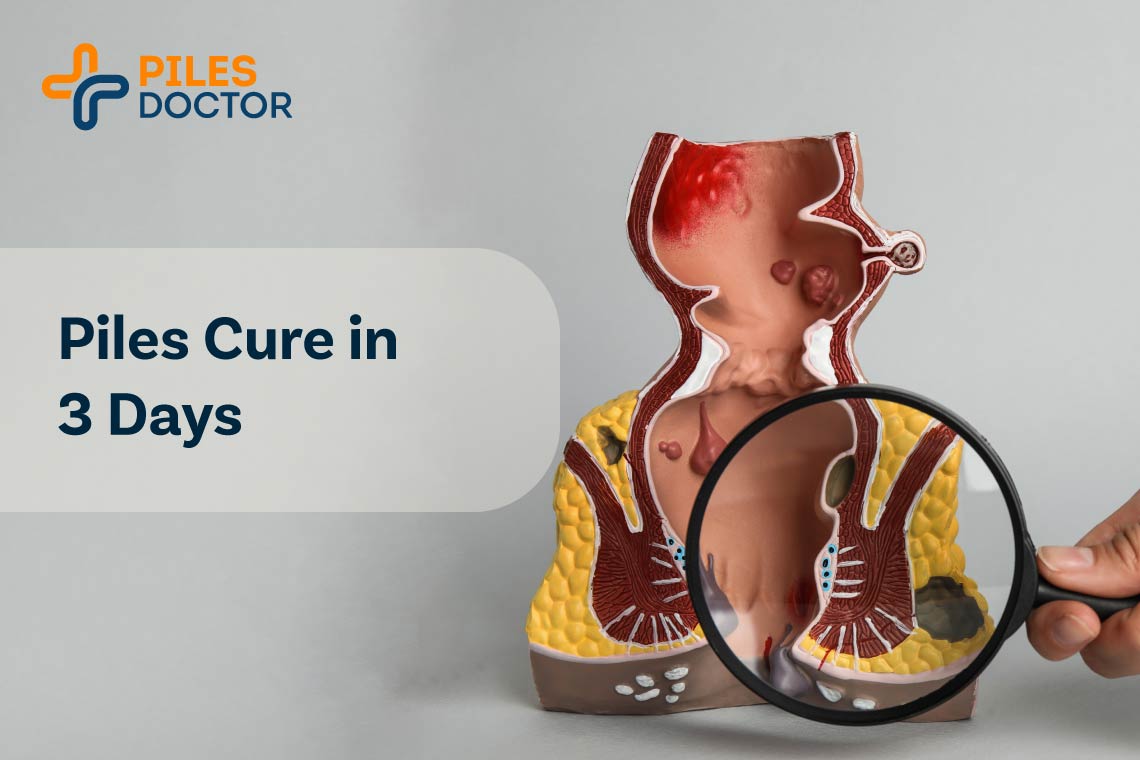Internal piles are small, swollen blood vessels inside the anus. This is a common anorectal condition that affects almost every 1 out of 4 people. Still, people feel shy talking about it. Everyone should understand what piles are, how they feel and how they can be treated. Let’s make it easy and less stressful. Read this blog to learn everything about internal piles.
So, let’s start by understanding ‘Internal Piles’.
They are categorized into different grades based on their severity.
Grade 1: Grade 1 piles are the mildest form of internal piles. They are small and found in the lining of the rectum. They do not protrude out of the anus and usually do not cause any symptoms. Internal hemorrhoids treatment often begins with conservative measures, like lifestyle modifications, sitz baths, topical creams or ointments, etc.
Grade 2: Grade 2 piles are larger than Grade 1 and may protrude during bowel movements. They protrude from the anus but spontaneously retract back into the rectum after the bowel movement. Treatment options for Grade 2 piles may include non-surgical interventions like rubber band ligation, infrared coagulation, and sclerotherapy.
Grade 3: Grade 3 piles also prolapse during bowel movements but do not retract independently. They need to be manually pushed back into the rectum. They may cause significant discomfort, pain, itching, bleeding, and difficulty maintaining proper hygiene. Treatment options for Grade 3 piles may include rubber band ligation, infrared coagulation, and sclerotherapy.
Grade 4: Grade 4 piles are the most severe and advanced stage. They remain prolapsed and cannot be manually repositioned. These piles are large, inflamed, and highly sensitive. Grade 4 piles can cause intense pain, bleeding, and hygiene difficulties. In addition, they may also be associated with complications such as thrombosis (blood clots) or strangulation.
Usually, internal hemorrhoids symptoms can be managed by dietary changes, lifestyle modifications, home remedies etc, but most advanced stages of piles can’t be managed with these conservative methods. Surgery will be the last option to treat the severe condition of piles.
Now, you might be wondering how to recognize the symptoms of internal piles.
Usually, the initial stage of internal piles is asymptomatic, as they grow and develop, several internal hemorrhoids symptoms may appear. Some common symptoms of internal piles includes,
- Pain and discomfort: Internal hemorrhoids can be extremely painful and cause a lot of discomfort due to swelling and inflammation in the internal rectum, especially during bowel movements. The pain may range from mild to severe, depending on the grade of the piles.
- Itching and irritation: Internal piles can cause a lot of itching and irritation, which can interrupt your routine activities. The swollen lumps in the rectum make it difficult to wash to anal area which can cause itching. This can be very uncomfortable and may lead to scratching, which can further irritate the area and cause more discomfort. It can be very discomforting and may lead to scratching which can lead to further irritation or bleeding.
- Internal hemorrhoids bleeding: You may notice bright red blood during bowel movements and while wiping. internal hemorrhoids Bleeding is a common symptom of piles and it depends on the severity of the condition.
- Feeling of fullness or heaviness: You may experience fullness or heaviness in your rectal area and it may feel a constant urge of bowel movements.
- Protrusion of piles: Sometimes, internal piles may protrude out of the anus while passing stools and cause extreme pain and discomfort.
- Mucus discharge: Internal hemorrhoids may lead to slimy discharge from the anal area and it can cause itching and irritation.
- It is important to note that internal hemorrhoids symptoms may vary for each individual, depending on the severity of the condition. If you experience any of these symptoms, consult an experienced proctologist for an accurate diagnosis and internal hemorrhoids treatment to avoid further complications.
How are Internal Piles Treated?
Your proctologist might see external piles, but diagnosing internal piles include the examination of the anal canal and rectum. Your doctor may suggest some diagnostic tests to evaluate the severity of the condition.
Medical history: During the consultation, your doctor may ask you about your internal hemorrhoids symptoms which may include pain, itching, and internal hemorrhoids bleeding etc. They may also ask you if you have a history of piles.
Digital Rectal Exam (DRE): In some cases, doctors may suggest DRE, in which they insert a lubricated glove into the rectum to check for lumps and any other abnormalities.
Anoscopy or Proctoscopy: These procedures involve using a small, lighted tube (anoscope or proctoscope) to examine the anal canal and rectum closely. They help assess piles’ location, size, and severity and guide the internal hemorrhoids treatment plan.
Sigmoidoscopy: This procedure uses a sigmoidoscope (a lighted tube with a camera) to view the lower colon and rectum. It helps identify conditions like piles and is available in flexible and rigid types.
Colonoscopy: Colonoscopy examines the large intestine for abnormalities, including rectal bleeding from piles or other internal haemorrhoids causes. It helps rule out serious issues, guiding the doctor in recommending the right internal hemorrhoids treatment.
After examination, the doctor will suggest the best suitable treatment plan, either non-surgical or surgical.
Non-surgical procedures
Rubber band ligation
Rubber band ligation is a procedure in which a doctor ties rubber bands around the piles, cutting off their blood supply, making them shrink and fall over time.
Here’re the steps mentioned that are followed during the rubber band ligation procedure to remove piles.
- Before starting the procedure, the doctor will give you topical anesthesia around the rectum to numb the area so you won’t feel pain during the procedure.
- Then the doctor uses a small tool (proctoscope) to evaluate the piles.
- Then the doctor uses a small device to tie piles with the rubber band. This will stop the blood flow to the piles.
- In a few days, the piles gets smaller because it doesn’t have blood and eventually falls off by itself.
The procedure is quick and easy. Usually, you don’t need to stay in the hospital.
The cost of rubber band ligation in India may lie between the range of INR 15.000 to INR 30,000.
Sclerotherapy
Sclerotherapy is an outpatient procedure in which the doctor injects a chemical into the piles to make the lumps hard and cut off their blood supply, eventually making them fall over time. Sclerotherapy is a quick and minimal painful procedure.
Here are the steps of sclerotherapy mentioned to help you understand the procedure quickly.
- You will lie on the bed and the doctor check the piles through a proctoscope.
- Then the doctor will inject a special chemical into the piles which makes the piles shrink gradually,
- Over a few weeks, the piles will get smaller because of the chemical and eventually disappears.
The cost of Sclerotherapy lies between the range of INR 10,000 to INR 20,000 in India.
Infrared Coagulation
Infrared coagulation is a procedure used to treat hemorrhoids. It involves the use of infrared light to coagulate blood vessels in the hemorrhoidal tissue, causing it to shrink and eventually disappear.
The steps of infrared coagulation involves:
- You will lie on your side, and the doctor use a small tool to look at the piles.
- The doctor uses a special tool that sends out infrared light. The light hits the piles and causes it to heat up.
- The heat from the infrared light makes a scar on the pile, which stops blood flow. Without blood, the piles gets smaller and eventually falls off.
The cost of infrared coagulation may lie between the range of INR 20,000 to INR 30,000 in India.
Surgical Treatments
Open Hemorrhoidectomy
This is an invasive procedure in which the doctor removes the piles by making large incisions around the anus. This is a preferred option for piles that have not responded to conservative methods or lifestyle changes.
- You will be sedated under general anesthesia so you don’t feel any pain during the procedure.
- Then the doctor will make a large incision around the rectum and cut off the piles.
- After the piles are removed, the doctor will stitch to close the wound.
- Over time, the surgical site will heal and you will feel better.
It might cost between the range of INR 30,000 to INR 60,000 in India.
Stapled Hemorrhoidectomy
In this procedure, the doctor uses a special stapling instrument to push back the piles lumps inside the rectum and then cut off the blood supply so the lumps can shrink.
Here’re the steps mentioned so you understand the procedure easily.
- You will be administered under general anesthesia so you won’t feel any pain or discomfort during the procedure.
- The doctor uses a stapling device to lift the piles back into their normal place. Then, they use the stapler to cut off the blood supply to the piles.
- Without blood, the piles get smaller and eventually fall off.
It might cost between the range of INR 40,000 to INR 80,000 in India.
Laser Hemorrhoidectomy
This is a procedure in which a laser or beam light is used to remove or cut off the piles. This minimally invasive procedure allows the more precise and targeted treatment to offer less pain and faster recovery than other surgical procedures.
Here are the step-by-step procedure of laser hemorrhoidectomy:
- The doctor will give you anesthesia so you won’t feel any pain or discomfort during the procedure.
- The doctor use a laser beam to cut or remove the piles. The laser light directly hit the piles, leaving healthy tissue untouched.
- Then the rectum area gets better over time after the surgery.
It is important to note that these cost brackets are rough estimates, and the actual cost may vary significantly for each individual.
How to Recover After Internal Piles Surgery?
Usually, you may take up to 4-5 weeks to recover completely after piles surgery. Although individual recovery times vary, many people can expect to see internal hemorrhoids symptoms resolve within about 1–2 weeks.
You can expect mild pain and discomfort after internal hemorrhoids surgery. Here are some tips to enhance your recovery after the procedure.
- Your doctor may suggest some over-the-counter medications to relieve pain and ease discomfort after the procedure. Follow your doctor’s instructions and take all the medicines on time.
- Sitz baths help ease post-surgical discomfort. Take a sitz bath several times a day after the surgery for up to 10-15 minutes daily. Add Epsom salt in warm water to relieve swelling and inflammation.
- Drink plenty of water to keep your body hydrated and prevent constipation as straining during bowel movements can cause pain and discomfort.
- Try to take ample breaks during your prolonged sitting job and avoid giving constant pressure to your anal area.
- Add fiber-rich foods to your diet to maintain healthy bowel movements. You can add broccoli, cabbage, fruits, avocados, whole wheat etc to your diet.
When to Consult a Doctor After Internal Piles Surgery?
Usually, risks and complications are rare after piles surgery. Still, if you are facing discomforting symptoms for more than 1 or 2 days after the surgery, you should consult the doctor. The following symptoms may warrant you to consul a doctor.
- You are experiencing extreme pain in your anal area.
- If you have a high fever, diarrhea.
- You’re not able to pass urine.
- You have thrombosed external hemorrhoids.
What if Internal Piles Left Untreated?
Internal hemorrhoids is usually asymptomatic, but you should seek proper internal hemorrhoids treatment on time to avoid further complications. Untreated piles can lead to various severe complications including;
- Extreme pain: Untreated internal piles can grow and can be extremely painful and discomforting.
- Infection: Untreated internal piles can get infected due to the lack of hygiene maintenance. Infected piles can be more painful and affect your daily life.
- Itching: Itching is the main symptom of piles and untreated piles can be very itchy. If you scratch your anus, it can lead to bleeding or become very painful.
- Bleeding: Internal hemorrhoids bleeding is common with internal hemorrhoids. You may experience bleeding during bowel movements and while wiping on toilet paper.
Like every disease, internal hemorrhoids develop with mild symptoms but if you leaving them untreated, it can complicate things. It is always recommended to seek proper medical attention if you suspect the symptoms of piles.
What are the Conservative Methods to Treat Internal Piles?
Usually, people prefer home remedies, dietary changes etc, to manage the symptoms before undergoing any surgical internal hemorrhoids treatment.
- Sitz bath: One of the most popular home remedies for piles pain is sitz bath. This involves sitting in warm water for 15 to 20 minutes. This helps to reduce the swelling and discomfort associated with piles. Additionally, the warm water helps to soften and relax the veins, allowing for easier passage of stool.
- Cold Compress: Cold compress is one of the best home remedies for piles. This helps to reduce the inflammation and pain associated with piles. Additionally, cold compresses can help to reduce the itching and burning sensation that can be associated with piles.
- Eat fiber-rich foods: Increasing fiber intake is also the best home remedy for piles. Fiber makes the stool soft and easier to pass. Additionally, it helps to keep the digestive system functioning well, reducing the pressure on the veins in the rectal area. Fiber can be found in fruits, vegetables, and whole grains.
- Aloe vera: Aloe vera is an effective and best home remedy for piles treatment. It helps reduce inflammation and swelling while promoting healing. It also has anti-inflammatory and antibacterial properties. Aloe vera is the best home remedy for piles pain. To use Aloe vera for the treatment of piles, extract the gel from the leaves and apply it directly to the affected area. Repeat this twice daily for best results.
- Coconut oil: Coconut oil is the best home remedy for external piles. It is effective in reducing inflammation and itching, as well as providing relief from burning sensations caused by piles. Coconut oil can be applied directly to the external piles several times a day for the best results. It is also a natural source of antioxidants, which can help improve overall health and reduce discomfort.
- Maintain a Healthy Diet: Consume a high-fiber diet: Include ample fruits, vegetables, whole grains, and legumes in your meals. These foods help regulate bowel movements and prevent constipation, a common cause of internal piles.
- Drink plenty of water: Staying hydrated softens stools, making them easier to pass and reducing the risk of straining during bowel movements.
- Don’t delay bowel movements: Ignoring the urge to have a bowel movement can result in dry and hard stools, increasing the likelihood of developing piles.
- Exercise Regularly: Engage in physical activity: Regular exercises, such as walking, jogging, or swimming, helps promote healthy digestion and prevents constipation. Aim for at least 30 minutes of moderate exercise most days of the week.
- What are the Best Foods to Add to Your Diet If You Have an Internal Piles?
The main aim of including these food in your diet is to relieve constipation, reduce straining during bowel movements and help you relieve the symptoms associated with piles. Here’s the list of foods that are good for piles.
- Leafy vegetables: Leafy vegetables are a great way to help reduce the symptoms of hemorrhoids. Dark, leafy greens like spinach and kale are high in fiber and help keep your digestive system regular. Eating a diet rich in leafy green vegetables can help to reduce inflammation and soothe the discomfort of piles.
- Whole grains: Whole grains are a great way to help manage piles. Foods like brown rice, oats, barley, and quinoa are rich in fiber, which helps reduce constipation and strain on the anal canal. Eating whole grains will also help keep the digestive system regular, reducing the chances of developing piles in the first place.
- Fresh fruits and vegetables: Eating plenty of fruits and vegetables, especially dark leafy greens, can provide essential vitamins and minerals to aid healing. Citrus fruits, such as oranges, are an excellent source of vitamin C, which is important for boosting the immune system and promoting healing.
- Sprouts: Sprouts are a great choice for those suffering from piles. Rich in antioxidants, minerals, and vitamins, they help reduce inflammation and improve digestion. Eating sprouts may also help reduce constipation, which is one of the main causes of piles.
- Legumes: Legumes are an excellent option for treating and preventing hemorrhoids. They contain a wealth of dietary fiber, which helps to soften stool and reduce strain on the anal area. Some legumes to consider include black beans, lentils, chickpeas, and kidney beans.
Foods to Avoid if you have Internal Piles
To reduce the pain and discomfort associated with piles, it is important to avoid certain foods.
- Processed foods: Processed foods such as chips, candy, and sugary drinks should also be avoided as they are high in fat and sugar. Eating too much of these foods can cause constipation, which can irritate the piles.
- Alcohol and caffeinated drinks: Alcohol and caffeinated drinks should be avoided as they can cause dehydration, making the symptoms of piles worse.
- Spicy foods: Spicy foods should also be avoided as they can cause irritation and inflammation in the rectum and anus.
- Fat-rich products:, Fat-rich products should be avoided as they can lead to digestive issues and worsen the symptoms of piles.
By avoiding these foods, you can reduce the symptoms of piles and live a healthier life.
Now you are aware of what foods to eat and what foods to avoid, here is an example of a day’s Indian piles diet plan.
- Breakfast (around 8:00 to 8:30 AM): Have one cup of oats or upma and half a cup of low-fat milk.
- Mid-meal (11:00 to 11:30 AM): Have one cup of plain curd with raw or grilled vegetables.
- Lunch (2:00 to 2:30 PM): Have half cup rice + two medium roti + half cup kidney beans curry + half cup snake gourd curry + half cup buttermilk.
- Evening (4:00 to 4:30 PM): Have three oatmeal or digestive biscuits.
- Dinner (8:00 to 8:30 PM): Have two roti with half-cup ridge gourd curry.
Remember to stay physically fit and active with whatever diet plan you follow.
It is important to note that conservative methods can alleviate the symptoms but not treat internal hemorrhoids permanently. Surgery is the best and most effective option to get rid of internal hemorrhoids.
Conclusion
Dealing with internal piles can be challenging, but with a variety of treatments, home remedies, and preventive measures available, managing them has become easier. Staying informed and proactive is key. Remember, early intervention can prevent complications and ensure a smoother recovery. Always prioritize your health and well-being.




